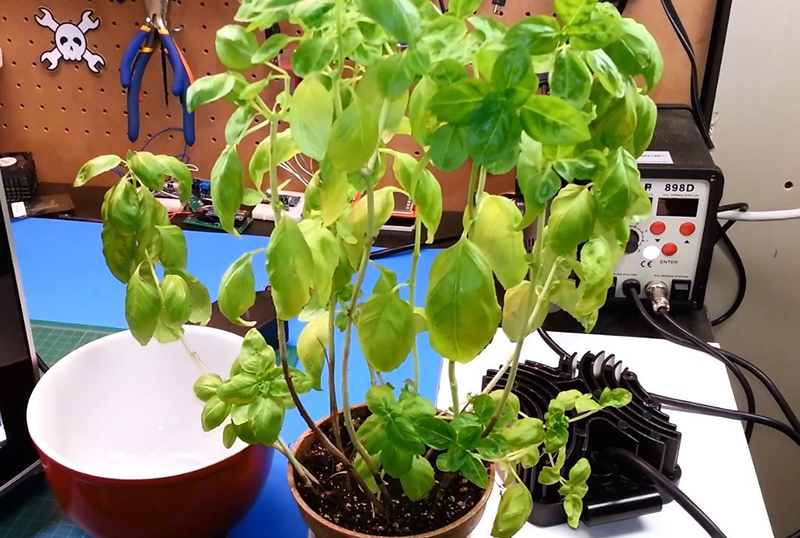[Eric] is used to growing his own food, and looked at the commercial options for growing veggies and herbs year round. It turns out the commercial options are terrible, with proprietary lighting, proprietary ‘seed pods,’ and no climate control.
Unsatisfied with the commercial options, [Eric] looked for a DIY solution. His entry for The Hackaday Prize is just that: an Urban Kitchen Garden.
The Urban Kitchen Garden was a peltier wide cooler in its former life, turned into a grow chamber with LED grow lights, an Arduino, a DHT11 temperature and humidity sensor, a soil moisture sensor, and an old Nokia LCD to keep track of everything. He’s been growing basil in it over the winter, and it just won’t die.
[Eric] won’t be growing tomatoes or beans in his tiny, desktop-sized garden, but it’s not really designed for that. It’s meant for herbs and seedlings, mostly, with larger plants moved outside when [Eric]’s Canadian winters finally subside.
There’s a video of the build, you can check that out below.





















I think a cooler K bulb would help with vegetative growth. Not a bad 1st generation setup but some things could be fixed up.
Or a grow light, even. Those probably do look weird though, with their pink glow and the glass door…
Well it looks weird anyway, why not just go full out with the efficiency? All that green light is wasted on plane leaves that reflect it.
Nice build. Perhaps a little too nice. Though it fits the kitchen decor, it’s in sharp contrast to its own contents. Anyone else feel this gives the impression the basil is some bio-hazardous substance under containment? ;) Maybe that’s just me, but I’d favor something more rustic in wood. Good functionality, even with the issue of having no direct heat path from the LEDs to outside, it seems to be working well enough.
100% Agree! Also, not wearing a pink polo shirt with a pastel scarf during the build would simply be a sin..
This would be good to grow tuberous drosera such as Drosera Peltata. That’s my little dream :-)
“..options for growing veggies and herbs year round” That is two DRAMATICALLY different things… You can grow herbs in a yogurt container on a window still or a LeeValley “Self-Watering Planter”. Veg requires a good supply of nutrients to produce any fruit at all. I ran an aquaponics setup one winter for lettuce and tomatoes and it was a PITA to get tiny wrinkly fruit out of them.
I recommended the Self-Watering Planter with a DIY PVC greenhouse and height adjustable T5HO 4lamp setup. Use the arduino for timed watering, lighting and a servo to open a venting flap for temp/humidity control.
Any good potting soil will provide more than enough nutrients for a season’s worth of growth and fruit. Lesser quality soil may require fertilizer, but that’s a simple $8 fix for a pound of 15-15-15. Plants like tomatoes have specific light spectra that make them fruit, plants like peppers don’t care about the spectra, only duration. You also must pollinate your plants but for a hobby scale plot, it’s not labor intensive.
Though it does feel a bit perverted doing self pollination with a paint brush.
Well you’re supposed to pollinate the plants, not yourself.
Yep no doubt a greenhouse is great hence so many people using them for so many years- but the average person wants something a bit more convenient I think… Aerogarden has made lots of $ based on this- including my $ but I found it simply sucked- hence my build. Not too many greenhouses will fit on a kitchen counter…Cheers
“The Urban Kitchen Garden was a peltier wide cooler in its former life”. I think you mean wine cooler, since it doesn’t look that wide.
Once it lost weight, it was let go from it’s previous employer. Cut it some slack.
Cool build. Seems like to get the most out of that setup he’d be better off starting some new basil that won’t shade out other plants.
For microgreens all the stuff I’ve read says you should grow them in the dark until they’re 1-2″ tall to get the most yield. Only exposing them to light a couple days before harvest.
Yep when not growing for demo I did various plants but trimmed all to the same height etc. As for micro-greens and sprouts- yep you can just kill the light cycle to suit and still keep temp and humidity as per your liking (most need no light like you say). Adjust up as desired through growth phase or pre-program in the code if you wish. I grew them below the other plants so I could easily kill the light down there.
Needs airflow. Plants grow from the air, not the dirt.
This looks super great, but is it not too small?
I’d want a more durable design not suseptible to rust and rot. Probably use polymers with injected foam for insulation, then a good light and peltier cooler.
Well it’s already made of a steel enclosure, foam insulation and a molded plastic for the entire interior. It is essentially the same as any fridge- just smaller and not compressor style cooling. I haven’t had anything rot or corrode yet :)
You need some sort of fan to circulate air (other than the cooling fan). Project is good , but yield will be low for a small enclosure. I could not help but think that the power consumed is not justified by the output growth. You could show that precise temp and humidity control produces higher growth rates?